Comforting, creamy, and perfectly rich, chicken alfredo looks and tastes fancy but actually only takes 30 minutes and a few simple ingredients to make! Cook chicken until golden brown and juicy and place it over a bed of pasta tossed with a garlicky, cheesy cream sauce. You will be adding this easy chicken fettuccine alfredo recipe to your regular rotation!
Quick tip: To make the thick, delicious alfredo sauce, heavy cream is a must. Also called heavy whipping cream, it has enough fat to withstand higher heat and will thicken up beautifully. Homemade chicken alfredo is divine with a side of garlic bread, breadsticks, or homemade garlic knots if you want something to soak up any leftover sauce in your bowl.
Ingredients
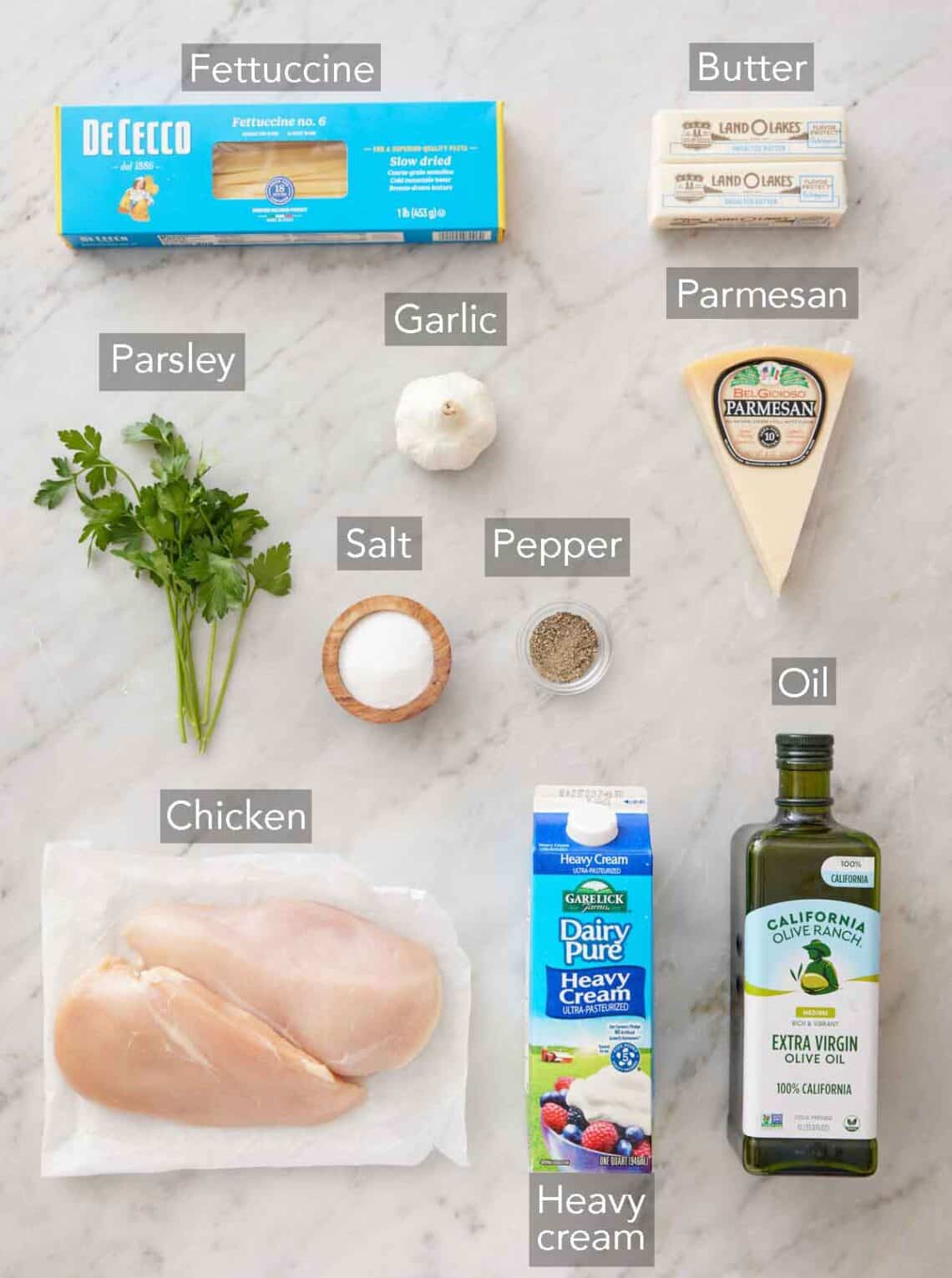
Pasta — fettuccine pasta is sturdy enough to hold the creamy sauce, so it’s my go-to for this recipe. You can also use linguine, penne, pappardelle, or large shells. Level it up by making making your own noodles with my homemade pasta dough recipe!
Chicken — boneless skinless chicken breasts are perfect for this recipe. If they are very thick, cut them in half crosswise.
Cream — heavy cream is a must for the most luscious, velvety pasta sauce. Whipping cream, half and half, and whole milk all have less fat and are more likely to break when heated; plus they also don’t thicken up very well.
Butter — I recommend using unsalted butter so you can control the saltiness of the dish.
Garlic — minced garlic adds a mouthwatering nutty flavor to the alfredo sauce. Substitute each garlic clove with 1/4 teaspoon of garlic powder if desired.
Cheese — use freshly grated parmesan cheese, which melts much better than pre-shredded cheese.
Parsley — chopped fresh parsley adds a bright pop of color and a fresh, peppery bite.
How to Make Chicken Alfredo
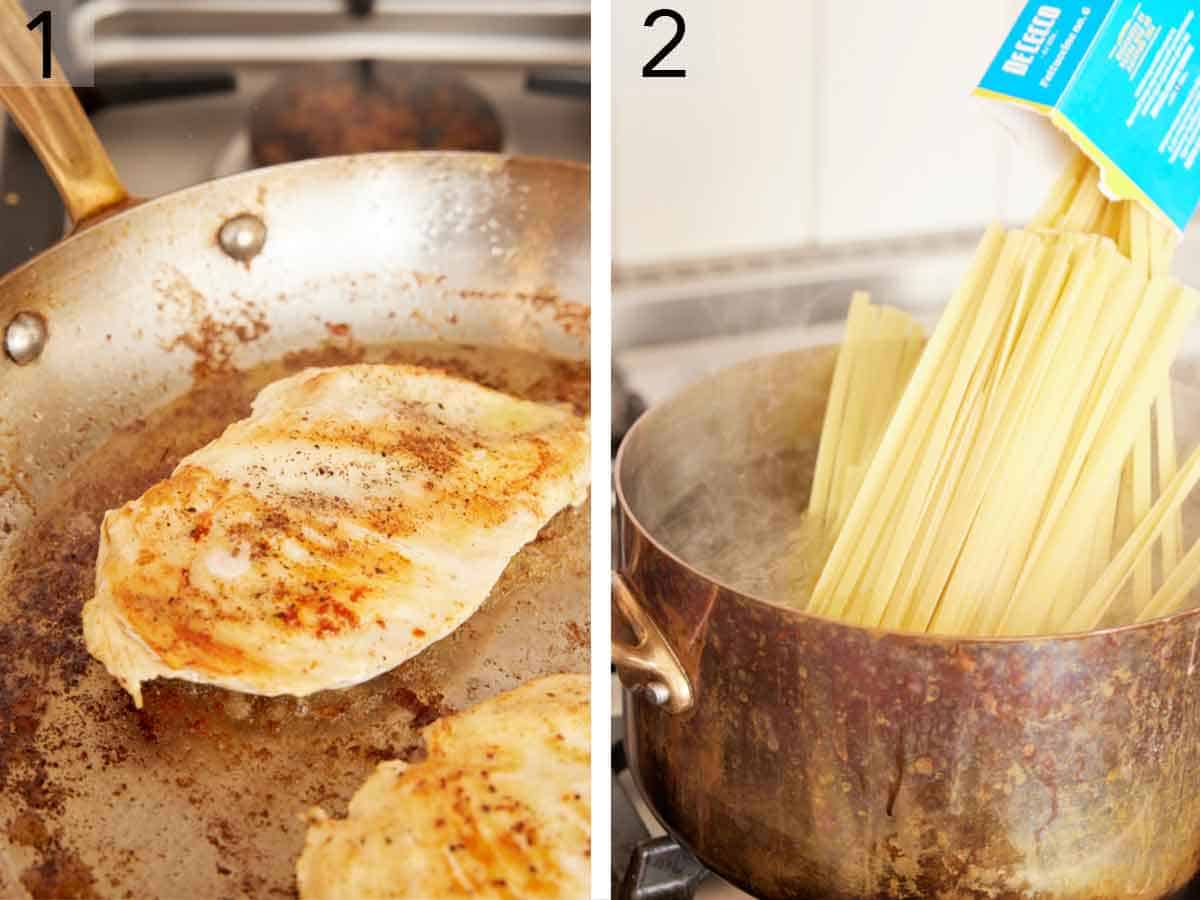
1. Heat the olive oil and butter in a large skillet over medium-high heat. Season the chicken with salt and ground black pepper and cook until browned on both sides. It should have an internal temperature of 165°F in the thickest part of the chicken breast. Remove from the skillet and cover to keep warm. Wipe the skillet clean.
2. Meanwhile, bring a large pot of salted water to a boil over medium-high heat. Add the pasta and cook according to the package directions until al dente. Drain well, reserving ½ cup of the pasta cooking water. Keep the pasta warm.
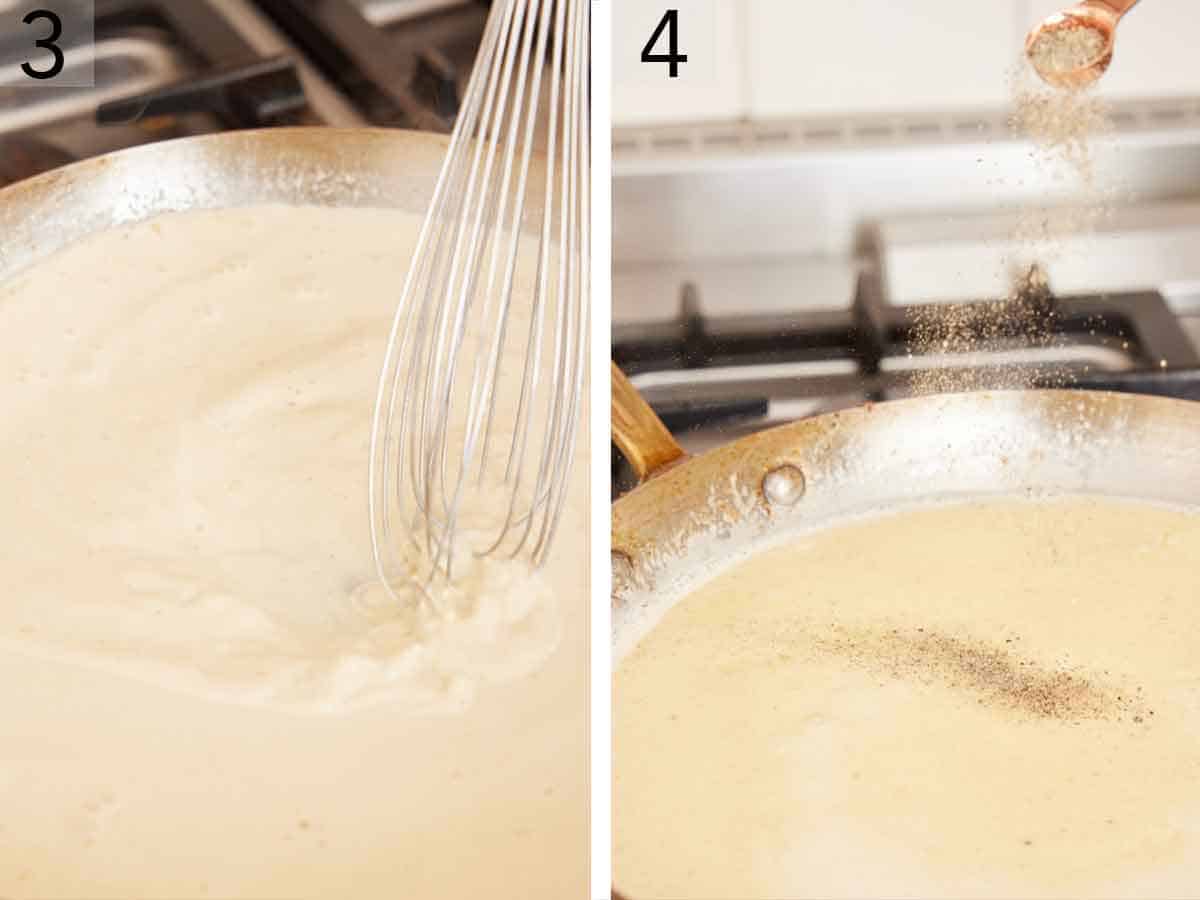
3. While the pasta cooks, combine the heavy cream, butter, and minced garlic in the same skillet that you cooked the chicken in.
4. Cook over medium heat, whisking often until the butter is melted. Then whisk in the salt and pepper and bring the sauce to a low simmer. Whisk constantly until the sauce is slightly thickened.
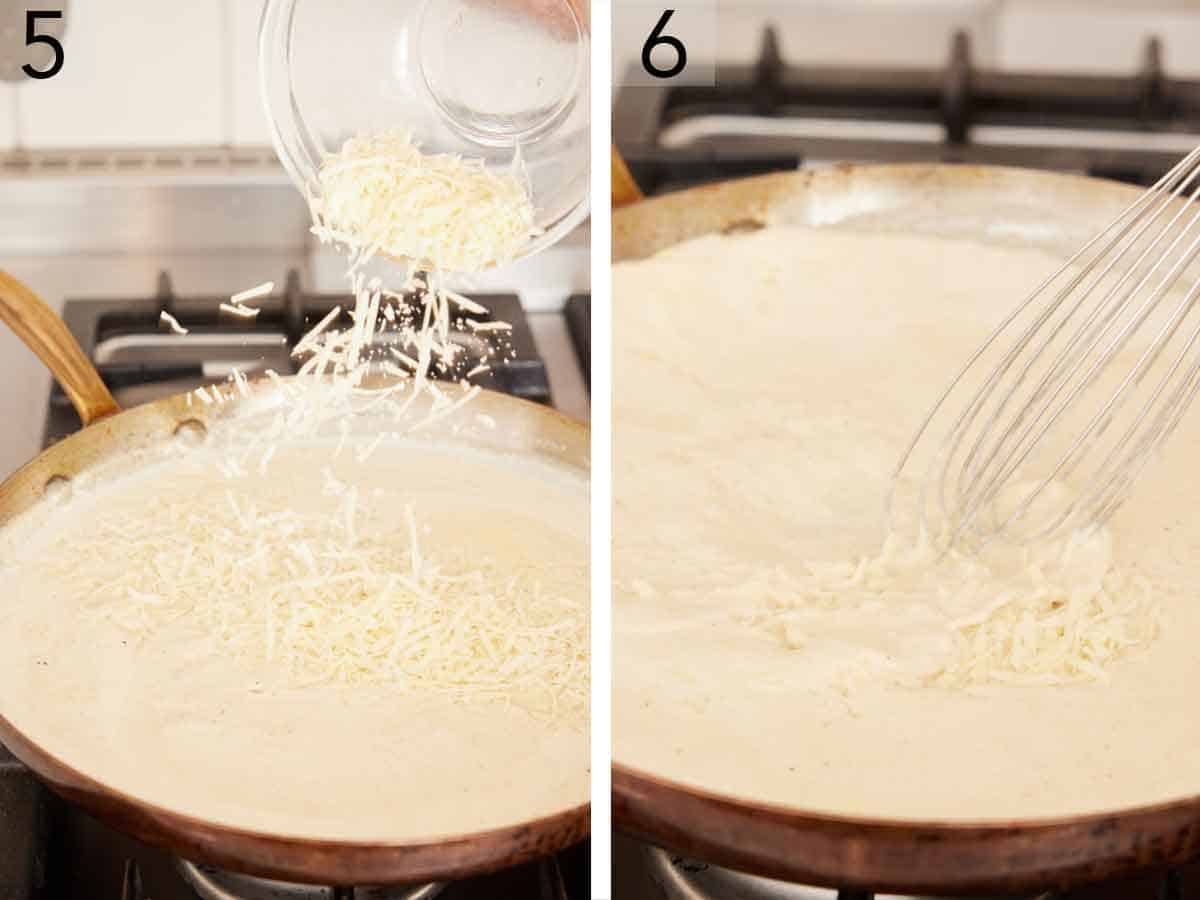
5. Add the grated parmesan cheese.
6. Whisk until the creamy sauce is smooth, and the cheese has melted.
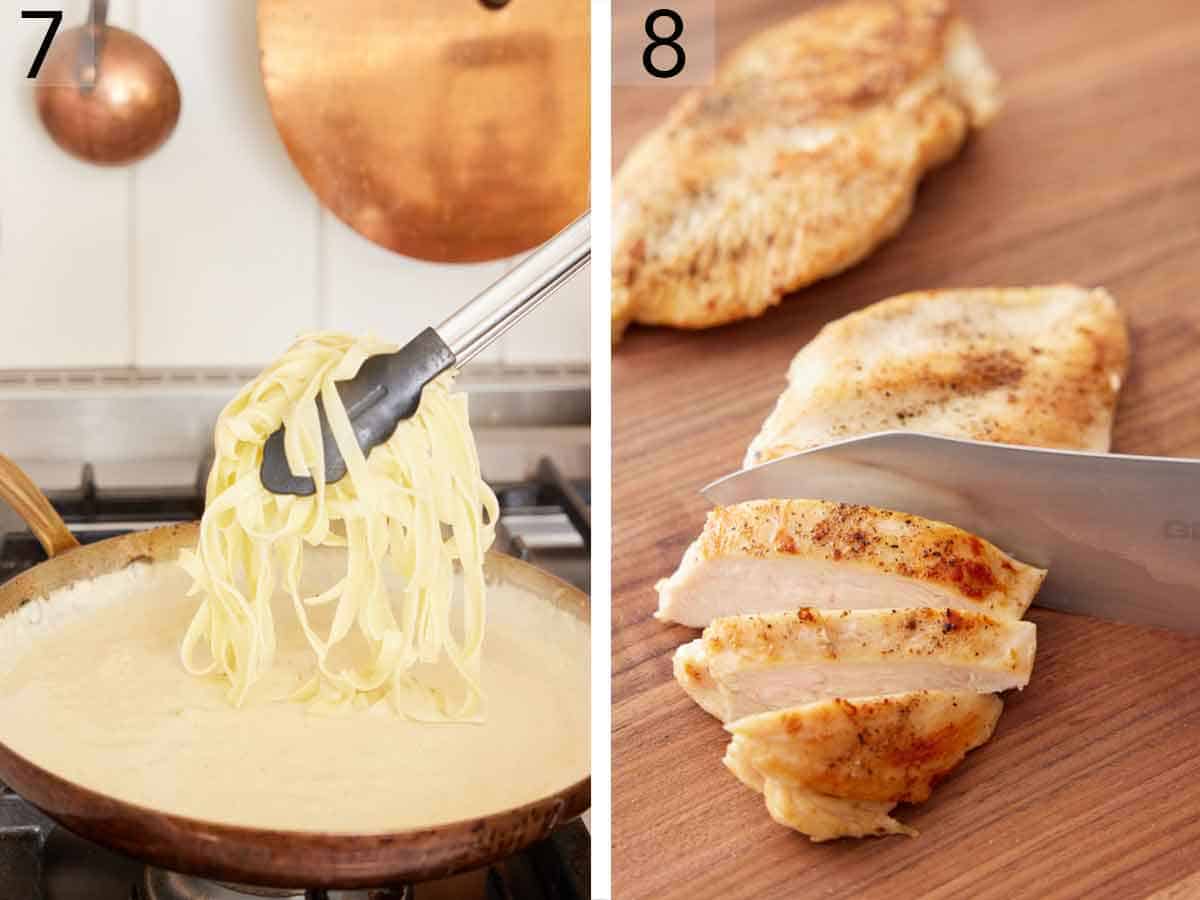
7. Remove the alfredo sauce from the heat and add the cooked pasta. Toss to coat, adding a bit of reserved pasta cooking water as needed to thin out the sauce.
8. Slice the chicken breasts into ½-inch-thick strips. Divide the pasta equally among 6 bowls, top with the sliced chicken, and garnish with fresh Italian parsley.
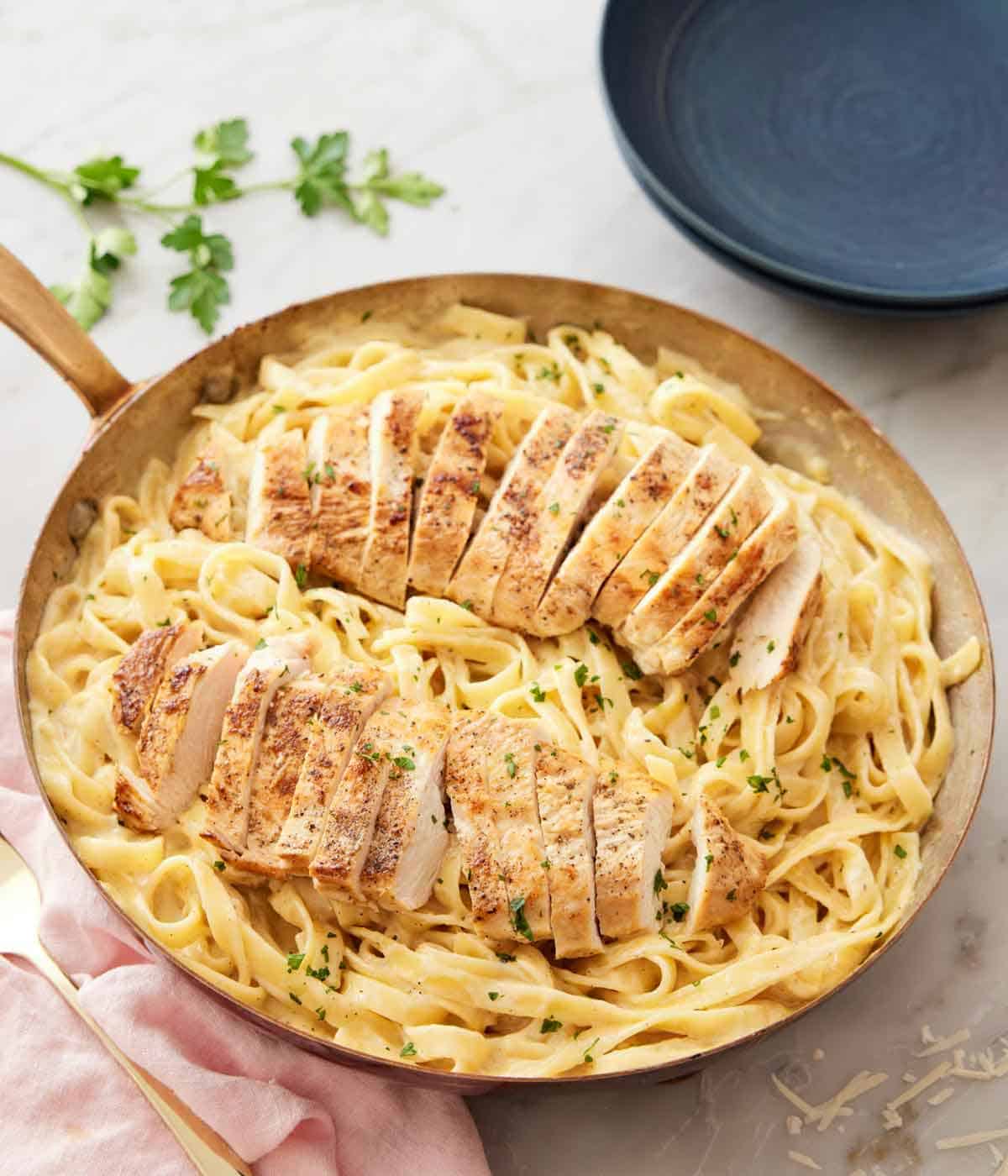
What Is The Difference Between Chicken Alfredo And Chicken Fettuccine?
Chicken alfredo refers to chicken served with pasta that is tossed in a creamy parmesan sauce (or alfredo sauce). Chicken fettuccine simply means chicken is served with fettuccine pasta. The sauce does not necessarily need to be creamy.
What To Serve With Chicken Alfredo
Since chicken fettuccine alfredo is quite a rich dish, I like serving it with a side of light, crisp-tender French green beans or air fryer asparagus.
How To Store Leftovers
Chicken alfredo pasta is best enjoyed fresh, but leftovers will keep in an airtight container in the fridge for up to 3 days.
What Is The Best Way To Reheat Chicken Alfredo?
To reheat leftovers, add them to a skillet over low heat. The sauce will have thickened up significantly in the fridge, so add a splash of heavy cream or chicken broth to thin it out again. Reheat until both the chicken and the sauce are hot. To save a few minutes, you can also microwave the dish in 30-second increments. Be sure to toss it intermittently.
Pro Tips for Making This Recipe
- Avoid overcooking the chicken. Once the thickest part of the chicken breast reaches 165°F, it is safe to eat. A kitchen thermometer is a useful tool to accurately measure the internal temperature of chicken so you don’t overcook it and dry it out.
- For added flavor: Season the chicken with 1 teaspoon of dried Italian seasoning before searing.
- Save pasta cooking water. It’s always a good idea to save a little pasta water when making pasta dishes. Pasta water thins out and emulsifies sauces and can also fix a broken cream sauce.
- Use freshly grated parmesan cheese. Freshly grated cheese will melt a lot better than the pre-grated kind. Grate your own parmesan cheese using a microplane or the small holes of a box grater.
- For a little heat: Add a few sprinkles of red pepper flakes to the sauce.
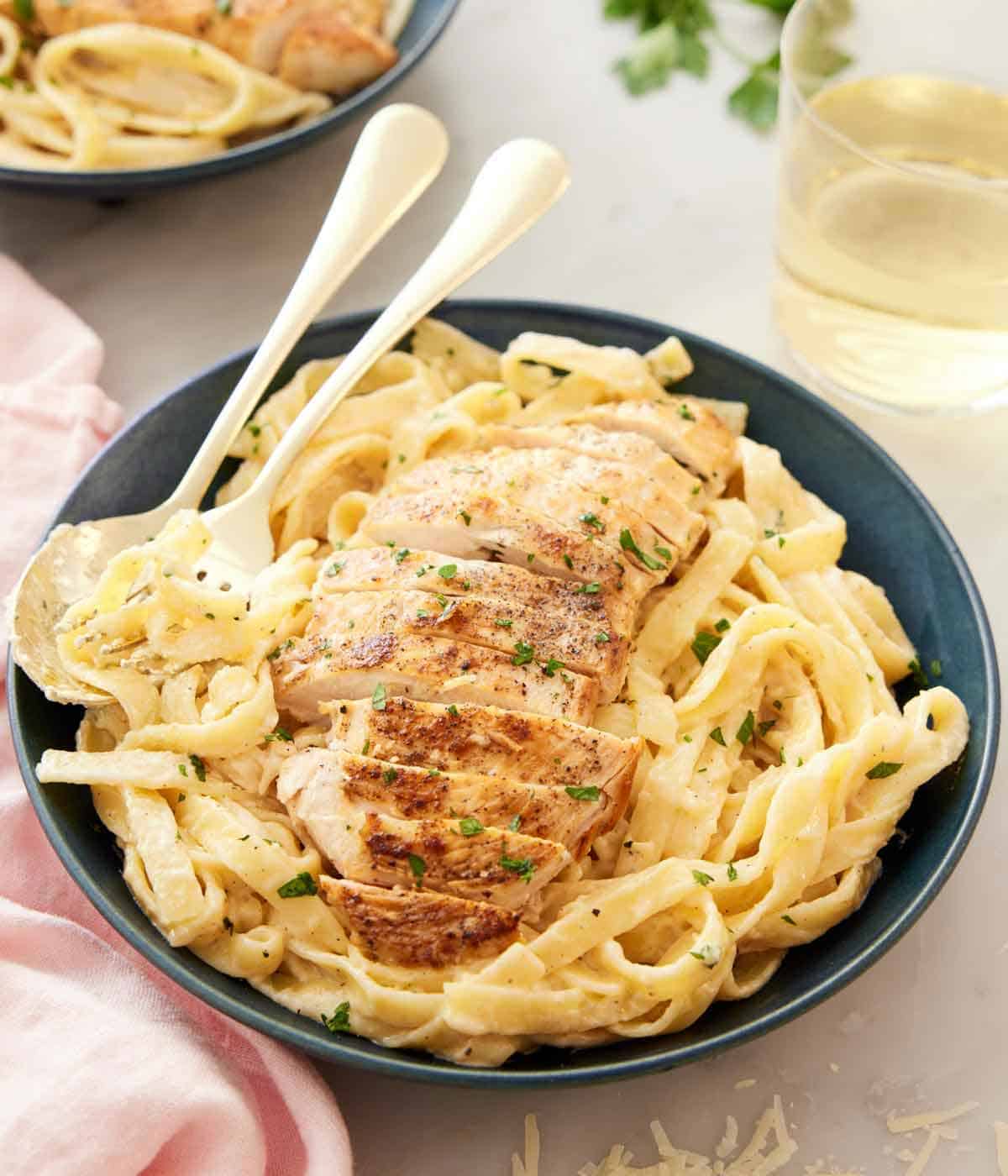
Frequently Asked Questions
This 30-minute meal is simple enough to cook on busy weeknights. Since the sauce is best eaten right away, I don’t recommend making it in advance.
Yes, you can, but I don’t recommend freezing it as the sauce can break and the cooked pasta becomes crumbly when you thaw the dish. If you do want to freeze it though, place it in a freezer-safe container and freeze for up to 3 months. Defrost in the microwave or overnight in the fridge.
For a lighter alfredo sauce, you can substitute about half of the heavy cream with half and half. The sauce will be thinner, though. I don’t recommend swapping all the heavy cream for half and half or milk because the sauce will be way too thin and lack any richness.
If you’ve tried this chicken alfredo recipe, then don’t forget to rate it and let me know how you got on in the comments below. I love hearing from you!
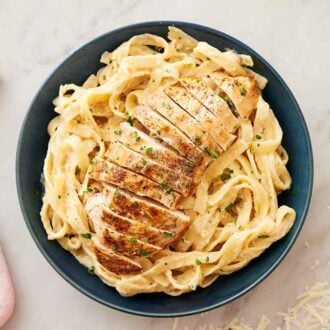
Chicken Alfredo Recipe
Video
Equipment
- Large Pot
- Large skillet
Ingredients
- 1 (16-ounce) package fettuccine pasta (454g)
- 1 pound boneless, skinless chicken breasts (halved crosswise if very thick/450g)
- ¾ teaspoon salt
- ¼ teaspoon ground black pepper
- 2 tablespoons olive oil
- 1 tablespoon unsalted butter
For the Sauce:
- 2 cups heavy cream (480mL)
- ½ cup unsalted butter cubed (113g)
- 3 cloves garlic minced (about 1 tablespoon minced)
- ½ teaspoon salt
- ½ teaspoon ground black pepper
- 1 cup grated parmesan cheese (90g)
- Chopped fresh parsley for garnish
Instructions
- Bring a large pot of salted water to a boil over medium-high.
- While the water is coming to a boil, season the chicken with salt and pepper.
- Heat the oil and butter in a large skillet over medium-high heat. Add the chicken, and cook until browned on both sides, about 7 to 9 minutes per side, and a thermometer inserted in the thickest part of each piece registers 165°F. Remove from skillet and cover to keep warm. Wipe the skillet clean.
- Add the pasta to the boiling water, and cook according to the package directions. Drain well, reserving ½ cup of the cooking water. Keep warm.
- For the sauce:
- While the pasta is cooking, combine the cream, butter, and garlic in the same skillet as you cooked the chicken. Cook over medium heat, whisking often until the butter is melted. Whisk in the salt and pepper. Bring to a low simmer. Cook, whisking constantly until slightly thickened, about 5 minutes.
- Gradually whisk in parmesan cheese until smooth. Remove from heat. Add the cooked pasta. Toss to coat, adding a bit of reserved cooking water as needed to thin the sauce.
- Slice the chicken breasts into ½-inch-thick strips. Divide the pasta among bowls, top with the sliced chicken, and garnish with parsley.
Notes
- Avoid overcooking the chicken. Once the thickest part of the chicken breast reaches 165°F, it is safe to eat. A kitchen thermometer is a useful tool to accurately measure the internal temperature of chicken so you don’t overcook it and dry it out.
- For added flavor: Season the chicken with 1 teaspoon of dried Italian seasoning before searing.
- Save pasta cooking water. It’s always a good idea to save a little pasta water when making pasta dishes. Pasta water thins out and emulsifies sauces and can also fix a broken cream sauce.
- Use freshly grated parmesan cheese. Freshly grated cheese will melt a lot better than the pre-grated kind. Grate your own parmesan cheese using a microplane or the small holes of a box grater.
- For a little heat: Add a few sprinkles of red pepper flakes to the sauce.



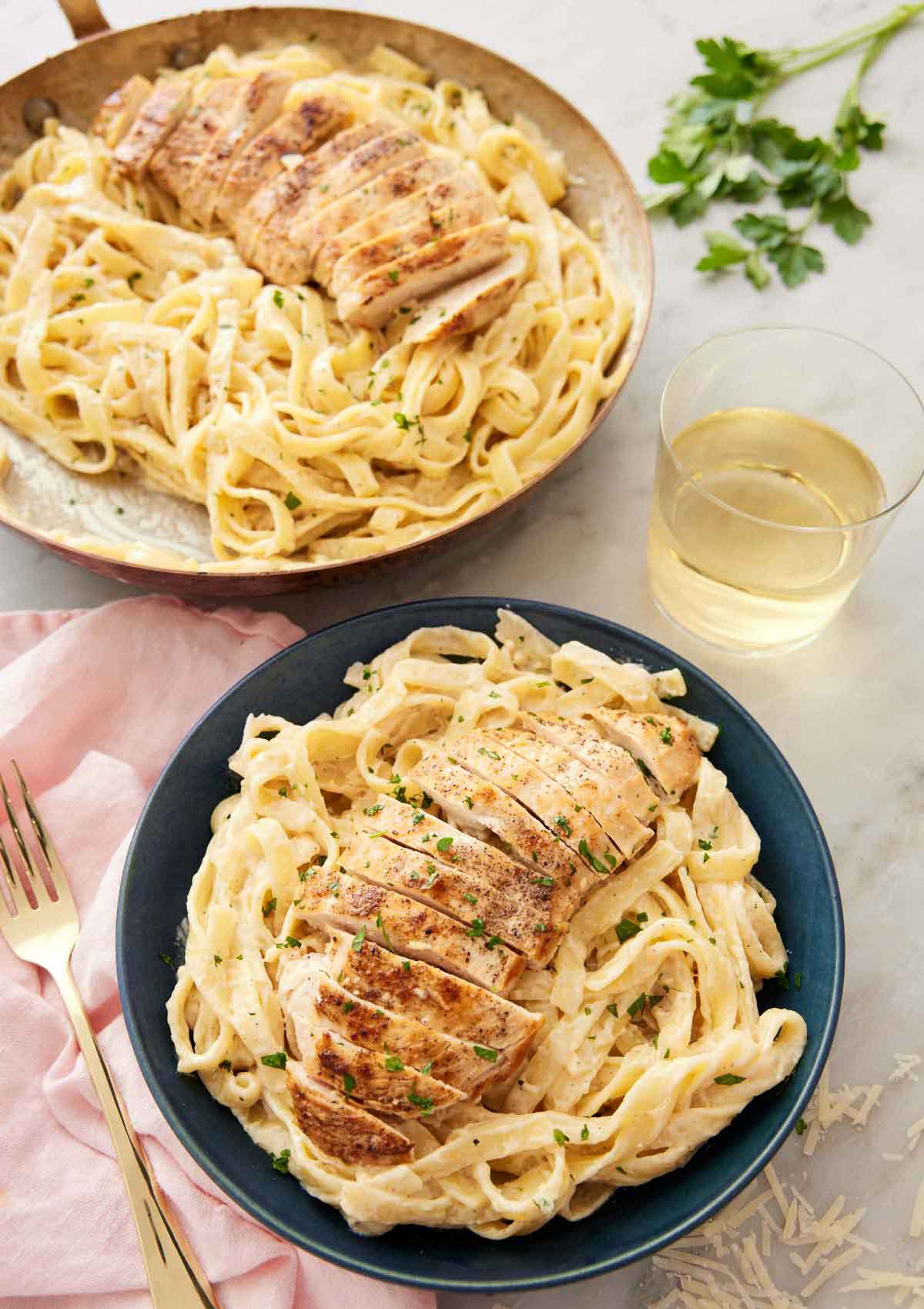
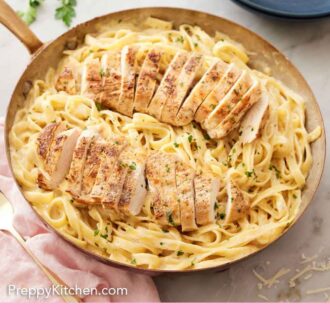
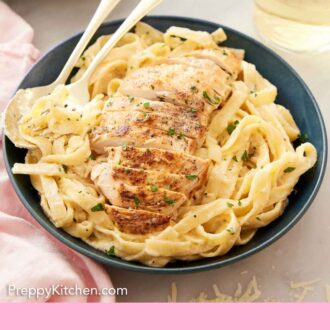
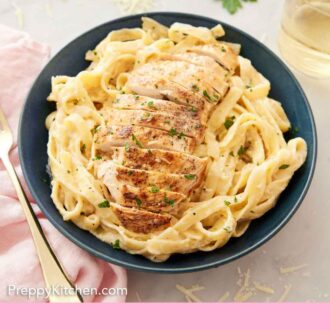
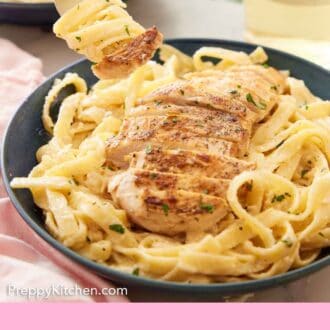
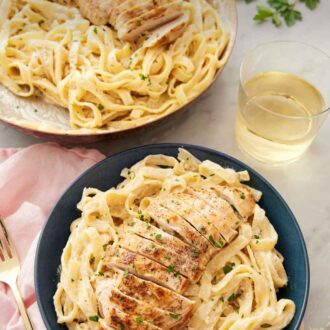
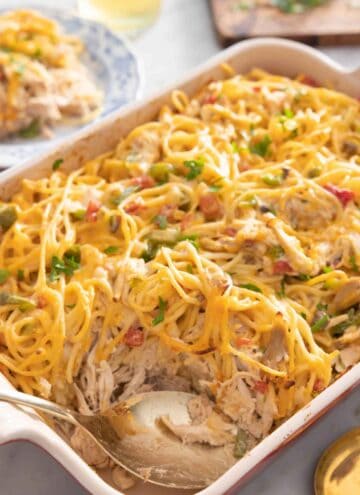
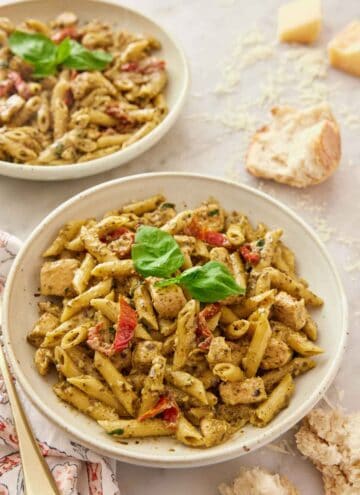
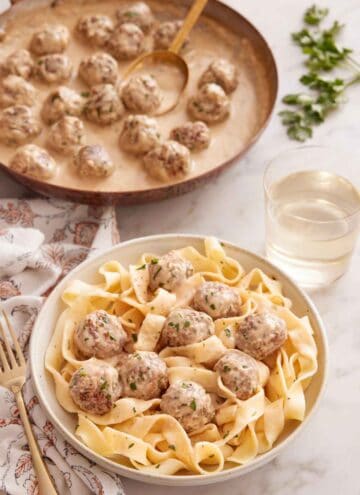
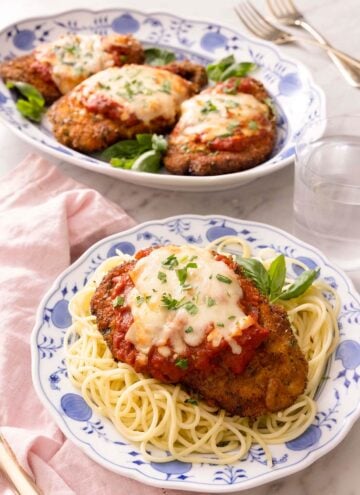
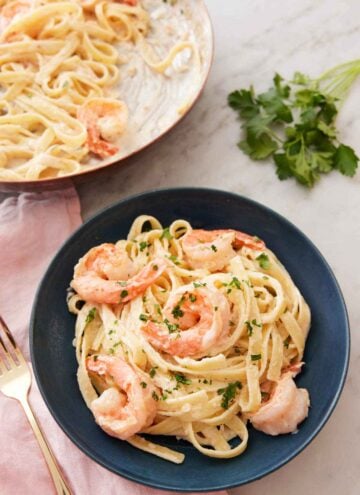
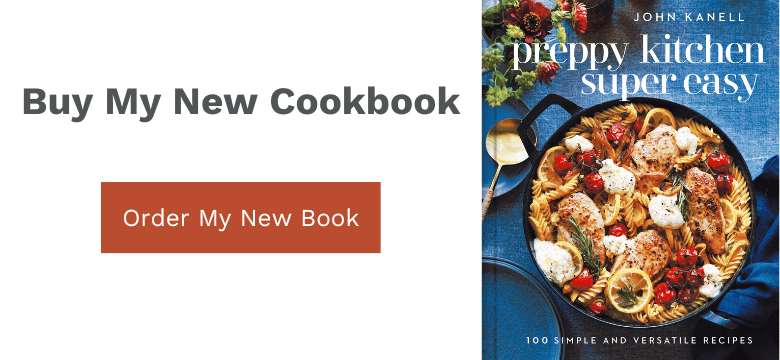
This was delightful, so creamy and savory!
Hey! Could I use sour cream instead of cream cheese for this recipe? Got some I need to use up 🙂
Thanks
Used the yogurt sauce with a homemade pasta and a grilled chicken and it was amazing! Lighter than a lot of white cream sauces, tastier, and healthier too! I put in lots of spinach and some mushrooms and cooked it all together. Whole family loved it!!
I’m going to try it in the first opportunity????
This was an excellent and quick dinner recipe that really impressed the unexpected dinner guests!!
To remove the garlic smell just rub your fingers along the backside of your knife as your wash it. Just be careful not to get too close to the sharp side. Crazy but it works! Learned this from Martha Stewart. Love her.
Soooo delicious!!! And I don’t feel extremely guilty for eating it! That’s the best part. It’s easy & full of flavor! I’ll be making it again for sure!! My husband loved it too (and he’s pretty picky…)
I tried this the other night and was amazingly surprised how delicious it was. Who needs all that extra fat. This works perfectly. My husband and friends loved it. Thanks again John, for another great surprise.
Just made this tonight for the first time, me, my partner and child loved it!!
what other cheese I can substutute can not found ‘FONTINA”?
regular gouda would be nice.
A most delicious dish to enjoy anytime! I love your recipe so much! My husband and I will definitely enjoy it!